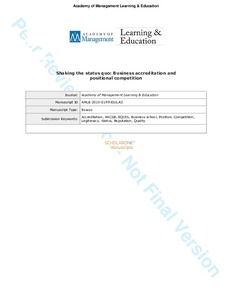Shaking the status quo: Business accreditation and positional competition
Kimmo Alajoutsijärvi; Sauli Sohlo; Kerttu Kettunen
https://urn.fi/URN:NBN:fi-fe2021042718472
Tiivistelmä
Modern business schools exist in a complex world of rankings, ratings
and credentials. Some argue that in increasingly competitive
global higher education markets, signaling status
and quality has actually become more important than being so (Gioia
& Corley,
2002; Trank & Rynes, 2003). For many
contemporary business schools, international accreditations have become
key means and
first steps in pursuing legitimacy and global
status. In this essay, we elaborate in detail on a business school's
international
accreditation process, including its motivations
and outcomes. We conclude that while accreditation processes are, at
best,
fruitful quality improvement exercises, the
inherent motivations stemming from the urge for organizational
legitimacy, status,
and reputation should not be overlooked by either
the accrediting agencies or business schools themselves. Ironically,
while
accreditation agencies (AACSB and EQUIS are the
focus of this essay) rarely explicitly encourage competition, their
exclusivity
seems to generate increasing competition between
schools that aspire to belong to 'the club'. For schools that gain
access
to the process, this means that on the flip side of
the happy and collaborative quality jump there is a much more serious
demarcation and revealing redefinition of the
accredited entity's future supporters, collaborators, partners, and
competitors.
Kokoelmat
- Rinnakkaistallenteet [19207]
